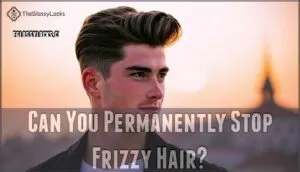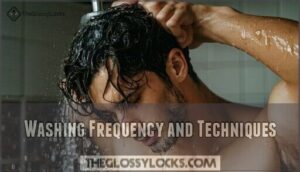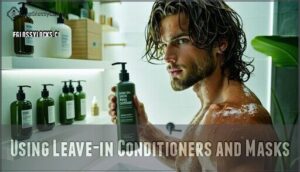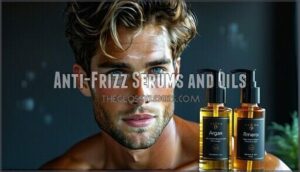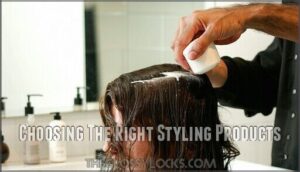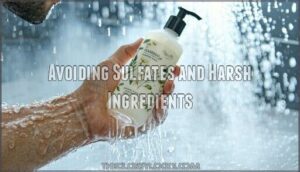This site is supported by our readers. We may earn a commission, at no cost to you, if you purchase through links.
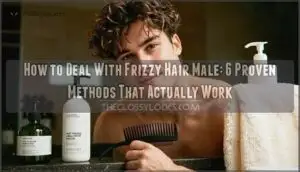
Skip the heat styling tools when possible, or use heat protectant if you must. A wide-tooth comb prevents breakage, and anti-frizz serum works like magic on stubborn strands.
Here’s what makes the difference: figuring out what your hair actually wants and learning the moves that turn morning disasters into something manageable.
Table Of Contents
- Key Takeaways
- Why Does Men’s Hair Get Frizzy?
- Can You Permanently Stop Frizzy Hair?
- Best Hair Care Routine for Frizzy Hair
- Top Products for Tackling Frizz
- Styling Tips for Men With Frizzy Hair
- Lifestyle and Professional Solutions
- Frequently Asked Questions (FAQs)
- What are the best hairstyles for men with frizzy hair?
- How often should I shampoo and condition my hair?
- What is the difference between hair oil and hair serum?
- How do I know which leave-in conditioner is best for my hair type?
- Does diet affect mens frizzy hair directly?
- Can stress make male hair more frizzy?
- Should men sleep on silk pillowcases for frizz?
- Do hair vitamins reduce frizz in men?
- Can exercise routines worsen mens hair frizz?
- Conclusion
Key Takeaways
- Wash less frequently with sulfate-free products – You’ll preserve your hair’s natural oils by shampooing only 2-3 times weekly, which prevents overdrying and reduces frizz-causing moisture absorption.
- Apply leave-in conditioner to damp hair and air dry – You can control frizz by using leave-in treatments on damp hair and avoiding heat styling tools that damage your hair cuticles.
- Use gentle drying and brushing techniques – You’ll minimize damage by patting hair dry with microfiber towels instead of rough terry cloth and using wide-tooth combs to prevent breakage.
- Choose hairstyles that work with your natural texture – You can embrace textured cuts like messy crops or undercut styles that complement frizzy hair rather than fighting against your hair’s natural pattern.
Why Does Men’s Hair Get Frizzy?
Your hair gets frizzy when the outer layer, called the cuticle, becomes damaged or lifted, allowing moisture from the air to enter and swell the hair shaft.
This happens due to humidity, lack of natural oils, heat damage, or simply your genetics determining your hair’s natural texture and porosity.
Hair Damage and Cuticle Health
When your hair’s cuticle layer gets damaged from heat styling or chemical treatments, it creates openings that let moisture escape. This leads to higher porosity and frizz as your strands can’t hold hydration properly.
Damaged cuticles also cause protein loss, making hair weak and unmanageable. Gentle hair treatments and careful styling protect your hair cuticle integrity.
Humidity and Weather Conditions
Weather acts like your hair’s worst enemy. Humidity makes your strands absorb moisture from the air, causing them to swell and lift. UV exposure breaks down proteins, making hair brittle and frizzy. Wind creates friction that damages cuticles. Pollution coats strands with particles. Extreme weather conditions stress your hair constantly.
Understanding these seasonal frizz triggers helps men develop better hair styling strategies.
Lack of Moisture
Beyond weather effects, your hair might be crying out for basic hydration. Dry hair acts like a sponge, desperately grabbing moisture from the air and swelling up. This creates that dreaded frizzy appearance.
Oil deficiencies strip your scalp health, while high porosity levels make hair moisture escape faster. Deep conditioning becomes your best friend for restoring balance and taming frizzy hair naturally.
Hair Type and Genetics
Your genetics play a bigger role than you might think. Some men inherit Hair Thickness and Curl Patterns that naturally create more frizz. Hair Porosity levels also come from Genetic Predisposition, affecting how your hair absorbs moisture. Different Hair Texture types handle humidity differently.
Consider these genetic factors:
- Coily hair has more bend points where breakage occurs
- Fine hair lacks weight to resist humidity’s effects
- High porosity hair absorbs moisture like a sponge
Can You Permanently Stop Frizzy Hair?
Here’s the reality about frizz: it’s not going anywhere permanently. But you absolutely can get long-term control with the right approach and consistent effort.
The key is managing your expectations and understanding that frizz control requires ongoing maintenance, not a one-time fix.
Managing Expectations
Can you really eliminate frizz forever? Unfortunately, no magic product exists that’ll permanently banish frizzy hair for good. Genetic factors play a huge role in your hair’s natural texture and frizz tendency.
Despite our best efforts with products and routines, genetics ultimately determines your hair’s natural frizz tendency—there’s no permanent cure, only ongoing management
Product limitations mean even the best men’s hair care items require a consistent routine and patience for lasting results.
Managing realistic goals is key—you can dramatically reduce frizz with proper hair care tips for men, but complete elimination isn’t realistic for most hair types.
Long-Term Frizz Control Strategies
Getting frizz under control long-term isn’t about finding one magic product. It’s about building habits that actually work.
Here are five strategies that make a real difference:
- Keratin Maintenance – Schedule professional treatments every 3-4 months to keep cuticles smooth
- Consistent Hydration – Use leave-in conditioners daily and deep conditioning masks weekly
- Scalp Health – Massage your scalp regularly to promote natural oil distribution
- Protective Styles – Choose hairstyles that minimize friction and environmental damage
- Healthy Lifestyle – Maintain proper nutrition and hydration for stronger hair from within
These habits work together over time. You won’t see dramatic changes overnight, but stick with them and your hair will become much more manageable.
Best Hair Care Routine for Frizzy Hair
The secret to taming frizz? It’s all about nailing your daily routine and finding products that actually work with your hair type.
You’ll need to wash less often, use moisturizing shampoo and conditioner, and add leave-in treatments to keep your hair smooth and manageable.
Shampoo and Conditioner Choices
Your shampoo choice makes or breaks frizz control. Sulfate-free shampoos preserve natural oils while hydrating conditioners with ceramides and oils rebuild damaged cuticles.
Co-washing between regular washes maintains moisture balance. Focus on protein balance—too much causes stiffness, too little leads to weakness.
A key step is to use leave-in conditioners to smooth frizz. Choose mens hair care products targeting scalp health and frizzy hair specifically.
Washing Frequency and Techniques
How often you wash your hair directly impacts frizz control. Most men overwash, stripping natural oils that protect against moisture absorption. Your hair washing frequency should match your hair type and lifestyle.
- Wash 2-3 times weekly – Daily shampooing removes protective sebum, leaving hair vulnerable to humidity
- Use lukewarm water temperature – Hot water opens cuticles, allowing moisture penetration and increased frizz
- Apply gentle scalp massage techniques – Stimulates circulation without aggressive rubbing that damages hair shafts
Pre-shampoo treatments with oils can shield hair during cleansing. Focus conditioner application on mid-lengths and ends where frizz commonly develops.
Using Leave-in Conditioners and Masks
Several leave-in conditioners and hair masks can transform your frizzy mane into manageable hair. Look for ingredients like argan oil and keratin in hair products.
Apply leave-in conditioner to damp hair, focusing on mid-lengths and ends. Try overnight masks weekly for deep conditioning.
Product layering works best when you start with lighter formulas first, then add heavier treatments to your hair care routine.
Top Products for Tackling Frizz
Finding the right products makes all the difference when it comes to taming frizz and maintaining smooth hair all day long.
Look for serums, oils, and styling products that add moisture while keeping your hair light and residue-free.
Anti-Frizz Serums and Oils
Hair serums and smoothing oils are your frontline defense against stubborn frizz. Look for serum ingredients like argan, keratin, and ceramides that repair damaged hair cuticles.
Application methods matter – use one pump on damp hair from mid-lengths to ends.
For cost comparison, quality oils deliver better benefits than cheap alternatives. Product combinations work best when layered properly.
Regular use of hair oil can help with locking in hydration.
Choosing The Right Styling Products
Beyond serums and oils, choosing hair products for men requires matching hold strength to your hair type. Medium-hold styling products work best for frizzy hair without weighing it down.
Look for cream-based formulas that provide shine level control and smooth application methods. Combine lightweight mousses with finishing creams for ideal product combinations that tame frizz effectively.
Avoiding Sulfates and Harsh Ingredients
Reading product labels becomes your best defense against frizz-inducing ingredients. Sulfate alternatives like cocamidopropyl betaine offer gentle cleansing without stripping natural oils. Smart ingredient research helps you choose hair products that foster healthy hair care.
- Look for natural shampoos with mild surfactants
- Avoid sodium lauryl sulfate in mens hair care products
- Check for moisturizing ingredients like glycerin
- Skip products containing drying alcohols
- Choose sulfate-free options for choosing hair products
Styling Tips for Men With Frizzy Hair
You’ll need the right styling approach to make frizzy hair work for you.
The key is using gentle techniques and choosing cuts that complement your hair’s natural texture, which can transform unruly hair into a manageable, stylish look.
Gentle Drying and Brushing Methods
How you dry and brush your hair can make or break your frizz battle. Your towel material matters – cotton creates friction, while microfiber towels gently absorb moisture. Air drying beats heat styling every time for frizzy hair texture control.
| Method | Best Practice |
|---|---|
| Towel Drying | Use microfiber or cotton t-shirt |
| Brushing Wet Hair | Apply wide-toothed combs only |
| Detangling Techniques | Start from ends, work upward |
Choose brush types carefully – boar bristle brushes distribute natural oils without damage. Men with frizzy hair need gentle detangling techniques to prevent cuticle lifting and breakage.
Recommended Haircuts and Styles
Choosing the right haircut transforms frizzy hair from unruly to stylish. Textured Crop styles work well for men with coarse hair, while Undercut Styles create clean lines that minimize frizz appearance. Curly Fringes complement natural texture beautifully. Tapered Sides add structure to long hairstyles.
Consider your hair type when selecting hairstyles for frizzy hair—proper hair styling starts with the foundation.
Embracing Natural Texture
Working with your natural hair texture beats fighting it every day. Texture enhancement products like sea salt sprays help define your hair’s unique pattern while reducing frizz.
Hair acceptance means understanding that some days your frizzy hair will cooperate better than others.
Curly confidence comes from proper men’s hair care routines that nurture your natural style rather than suppress it.
Lifestyle and Professional Solutions
The things you do every day—plus some professional help—can really turn the tide against frizz.
Good nutrition, shielding your hair from harsh weather, and treatments like keratin all work as a team to give you smoother, easier-to-style hair.
Nutrition and Hydration Tips
Your hair’s health starts from within. A balanced diet rich in omega-3 healthy fats, biotin, and zinc promotes strong hair follicles.
Drink eight glasses of water daily for ideal hydration and hair moisture.
Nutrient-rich foods like salmon, nuts, and leafy greens provide essential vitamins. Consider vitamin supplements if your diet lacks key nutrients for hair health.
Protecting Hair From Environmental Damage
Environmental factors wage war against your hair daily. UV protection shields strands from sun damage and brittleness.
Air pollution clogs cuticles, while humidity management through indoor climate control reduces moisture absorption.
Water quality matters—install filters to remove chlorine and minerals that strip hair moisture.
Simple protective steps prevent environmental hair damage effectively.
Keratin and Salon Treatments
When traditional methods aren’t cutting it, professional keratin treatments offer serious frizz control. These salon smoothing services last 3-6 months and reduce styling time by half.
Keratin masks and hair rebonding provide deeper solutions, though formaldehyde-free options are safer.
Professional treatments cost $150-500 but deliver results you can’t achieve at home.
Frequently Asked Questions (FAQs)
What are the best hairstyles for men with frizzy hair?
You’ll find messy, textured cuts work best. They embrace your natural texture instead of fighting it. Try shorter sides with longer tops, or go for a relaxed shag style.
How often should I shampoo and condition my hair?
You’ll want to shampoo every 2-3 days instead of daily. This preserves your natural oils that fight frizz. Condition every time you shower, even when skipping shampoo days.
What is the difference between hair oil and hair serum?
Hair oil penetrates your hair shaft to moisturize from within, while serum coats the surface to create a protective barrier. Oil’s heavier, serum’s lighter and faster-absorbing.
How do I know which leave-in conditioner is best for my hair type?
Exploring the maze of leave-in conditioners doesn’t have to be overwhelming. Check your hair’s porosity by dropping a strand in water—if it sinks quickly, you need lightweight formulas.
Thick, coarse hair craves heavier creams with oils.
Does diet affect mens frizzy hair directly?
Yes, your diet directly impacts frizzy hair. Poor nutrition weakens hair structure, making it more prone to frizz. Eat protein, omega-3s, and vitamins for stronger, smoother hair.
Can stress make male hair more frizzy?
Stress absolutely makes your hair frizzier. When you’re stressed, your body produces cortisol, which disrupts natural oil production and weakens hair cuticles, making strands more prone to moisture absorption and frizz.
Should men sleep on silk pillowcases for frizz?
Silk pillowcases reduce friction between your hair and the surface, preventing cuticle damage that leads to frizz. They’re gentler than cotton, helping maintain your hair’s natural oils and smoothness overnight.
Do hair vitamins reduce frizz in men?
Hair vitamins won’t directly reduce frizz unless you’re deficient. They help healthy hair in deficient individuals but lack evidence for frizz control in most men. Focus on moisturizing products instead.
Can exercise routines worsen mens hair frizz?
Exercise can worsen frizz because sweat damages hair and makes it frizzy. When you work out, moisture from sweat causes hair to swell and creates a frizzy texture after your routine.
Conclusion
Studies show that 85% of men experience frizz due to damaged hair cuticles and improper care routines. Learning how to deal with frizzy hair requires consistent application of proven methods.
You’ve discovered six effective strategies: proper washing techniques, moisture retention, gentle styling, and professional treatments. Remember that controlling frizz isn’t about fighting your hair’s natural texture—it’s about working with it.
Start with sulfate-free products and consistent hydration. Your hair will thank you for the patience and proper care.
- https://science.howstuffworks.com/nature/climate-weather/atmospheric/why-does-humidity-make-hair-frizz.htm
- https://kilgourmd.com/blogs/news/frizzy-hair-men-how-to-tame-the-mane-and-look-sharp
- https://cosmeticsbusiness.com/top-5-hair-care-trends-2024
- https://www.mankindbarbersnyc.com/blog/hair-care-and-styling-tips/the-2024-guide-to-healthy-frizz-free-hair-for-men
- https://www.hims.com/blog/keratin-treatment-men

